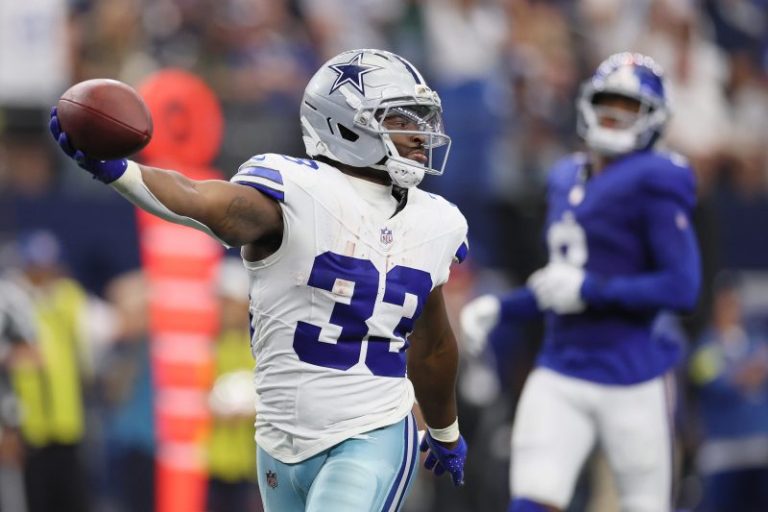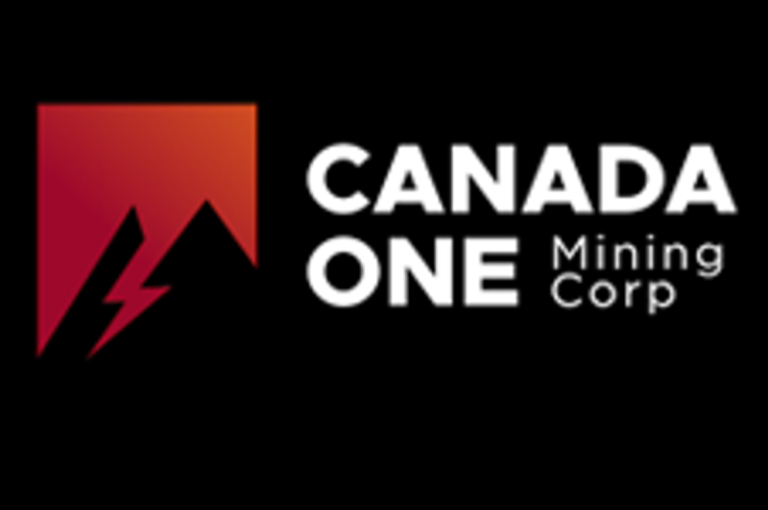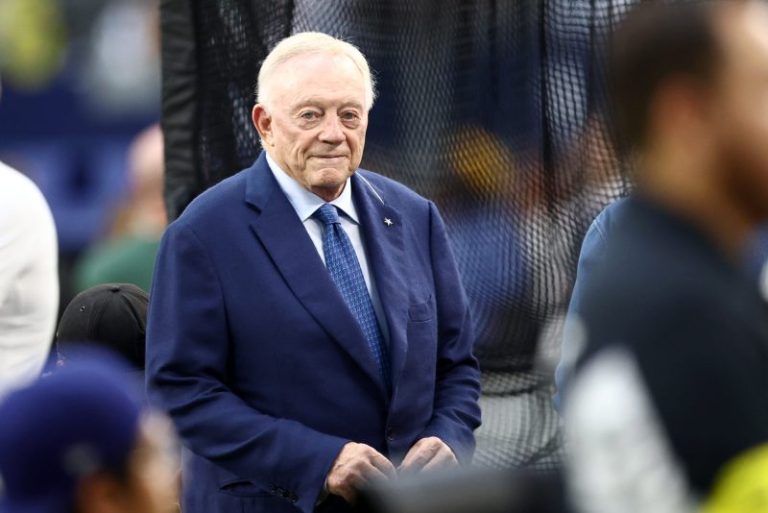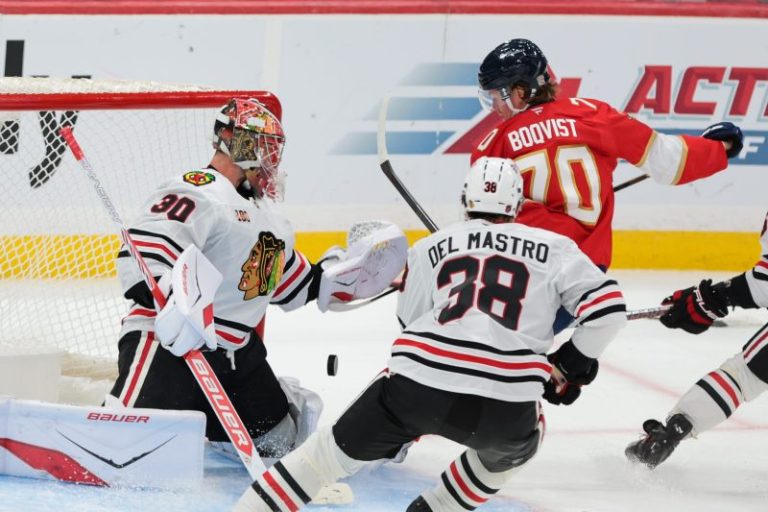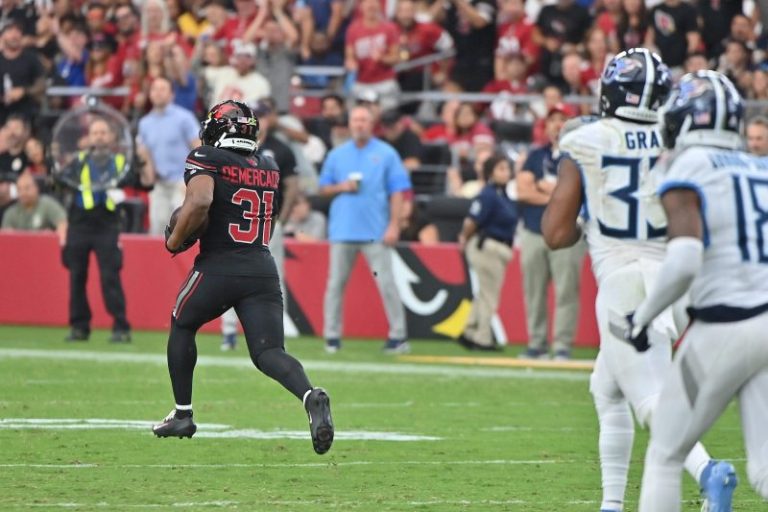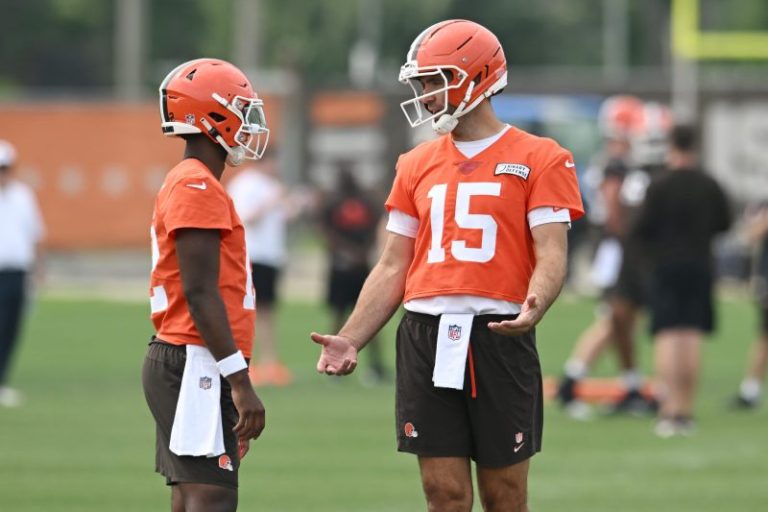- Florida Panthers’ quest for third consecutive championship opens with win vs. Chicago Blackhawks.
- Newcomers help Pittsburgh Penguins defeat New York Rangers on opening night of the 2025-26 NHL season.
- The first fight of the 2025-26 NHL season featured Nick Foligno of the Chicago Blackhawks vs. A.J. Greer of the Florida Panthers.
The Florida Panthers raised their Stanley Cup banner on the opening night of the 2025-26 NHL season and showed the efficiency they need to push for a third consecutive championship.
The Panthers downed the Chicago Blackhawks, 3-2, on Oct. 7, dominating early by outshooting them 17-3 and in the first period and 37-19 for the game. Only the play of Chicago goalie Spencer Knight, traded by the Panthers last season, kept the game close.
Though the Blackhawks tied the game in the second period, Jesper Boqvist batted the puck out of the air in the third period to give Florida a 3-2 lead it wouldn’t relinquish.
The Panthers showed they had the depth they need with Aleksander Barkov out seven to nine months and Matthew Tkachuk out until December or longer.
And they avoided more injuries as Sam Reinhart and Evan Rodrigues left briefly and A.J. Greer was slow getting up at one point. But all finished the game.
Exclusive book: Relive the Panthers’ latest Cup
The Pittsburgh Penguins shut out the New York Rangers, 3-0, in the second game of the opening night ESPN tripleheader behind offseason acquisition Arturs Silovs. Another newcomer, Justin Brazeau, scored twice, the first one on a Rangers defensive breakdown that left him alone in front.
Coach Mike Sullivan, in his Rangers debut, fell to his former team, now led by first-time NHL head coach Dan Muse.
In the final game of the NHL’s season-opening tripleheader, the Colorado Avalanche defeated the Los Angeles Kings, 4-1.
Here are highlights from the NHL’s opening night:
Avalanche vs. Kings highlights
Final score: Avalanche 4, Kings 1
Martin Nečas scored two goals as the Colorado Avalanche picked up a season-opening road win over the Kings in Los Angeles.
Artturi Lehkonen and Sam Malinski scored a goal apiece for Colorado, which is hoping its embarking on a ninth consecutive playoff season.
Rangers vs. Penguins highlights
Final score: Penguins 3, Rangers 0
Big night by Justin Brazeau, who had two goals in his Penguins debut. His first, late in the first period, was the game-winner. He then added an empty-netter, as did Blake Lizotte. Goalie Arturs Silovs also had a solid Penguins debut, recording a 25-save shutout.
All of the pregame focus was on new Rangers coach Mike Sullivan facing his former team, but Dan Muse ended up with the win in his NHL head coaching debut.
End of second period: Penguins 1, Rangers 0
The Rangers looked better in that period but they can’t get the puck past Arturs Silovs. He made a big save on Mika Zibanejad to keep the Rangers scoreless.
End of first period: Penguins 1, Rangers 0
Pretty evenly played period. Rangers could have escaped with a tie, but gave up a Justin Brazeau goal because of a defensive breakdown off a faceoff.
Who is Justin Brazeau?
Justin Brazeau, the Penguins scorer, signed a two-year contract and is in his first year in Pittsburgh. The 6-6 forward previously had played with the Minnesota Wild and Boston Bruins. He had 16 goals in 95 games heading into the season.
Score update: Justin Brazeau gives Penguins lead
A Rangers defensive breakdown leads to Justin Brazeau’s goal with 32 seconds left in the first period. He’s left alone in front, takes a pass from Evgeni Malkin and makes a nice move to beat Igor Shesterkin.
Rangers vs. Penguins prediction
4-3 Rangers. Coach Mike Sullivan gets a win against his former team.
Panthers vs Blackhawks highlights
Final score: Panthers 3, Blackhawks 2
The Panthers showed a lot of speed to get past the Blackhawks in the opener. Chicago goalie Spencer Knight was called upon often and kept his team in the game. But though the Blackhawks scored first and tied the game in the second, Florida’s depth won out. Blackhawks forward Frank Nazar will be dangerous this season.
Panthers win
The plastic rats fly onto the ice as the Panthers open their defense of their Stanley Cup title with a 3-2 victory against the Blackhawks.
Spencer Knight goes to the bench
It took a while but the Blackhawks goalie is finally able to get to the bench for an extra skater.
Less than five minutes left
Chicago’s Spencer Knight makes a glove save on Brad Marchand to keep the score 3-2 Florida.
Score update: Panthers take lead
Mackie Samoskevich chips a pass to Jesper Boqvist, who bats in out of the air and past Spencer Knight at 9:40. Panthers 3, Blackhawks 2
Blackhawks power play
Luke Kunin called for high-sticking. Chicago 0-for-2 so far. Florida kills it off. Ryan Donato makes several nice moves but is stopped by Sergei Bobrovsky.
Third period underway
Score tied 2-2.
End of second period: Panthers 2, Blackhawks 2
The Blackhawks played better that period after getting badly outshot in the first period. Teuvo Teravainen tied the game early and drew a couple penalties, but the Blackhawks couldn’t convert on the power play. The Panthers played briefly without Sam Reinhart and Evan Rodrigues after they were hit by pucks, but they returned. A.J. Greer was slow to get up late in the period.
Sam Reinhart injury update
He’s back on the ice after getting stitched up.
Blackhawks power play
Seth Jones goes off for slashing. Panthers kill it off. Sergei Bobrovsky makes a shoulder save on Connor Bedard.
Panthers injury updates
Evan Rodrigues is back on the ice. Coach Paul Maurice tells ESPN that Reinhart is getting sewn up and should be back soon.
Evan Rodrigues injury update
The Florida forward is helped off the ice after being hit by a puck in the leg. He joins teammate Sam Reinhart in the dressing room.
Blackhawks power play
Brad Marchand is called for holding the stick. Florida kills it off but Sam Reinhart heads off after being hit by a puck in the face.
Score update: Blackhawks tie it up
The Blackhawks come out strong in the second period with two breaks up ice. Teuvo Teravainen scores on the second chance off a 2-on-1 break with Frank Nazar. Nazar picks up his second point of the game.
Second period underway
2-1 Florida.
End of first period: Panthers 2, Blackhawks 1
Fun period, but it showed why the Panthers are Cup winners and the Blackhawks are expected to finish near the bottom of the league. Florida had a 17-3 edge in shot, but ex-Panthers goalie Spencer Knight is keeping it close with some big saves. Anton Lundell hit the post late to keep it a one-goal game. A.J. Greer has a goal and a fight. Needs an assist for a Gordie Howe hat trick.
First fight of the season
Chicago’s Nick Foligno vs. Florida’s A.J. Greer.
Score update: Carter Verhaeghe puts Florida ahead
Verhaeghe gets the puck at the side of the crease and beats Spencer Knight on the power play. 2-1 Panthers.
Panthers go on power play
Artyom Levshunov goes to the penalty box again, this time for tripping Brad Marchand.
Score update: Panthers tie game
The Panthers fourth line comes through as A.J. Greer scores on a rebound at 11:06. 1-1.
Score update: Blackhawks take lead
Chicago’s Frank Nazar gets a breakaway and beats Sergei Bobrovsky at 10:03. He just signed a big extension and is in the mix for Team USA at the Olympics. 1-0 Blackhawks.
Panthers go on power play
Artyom Levshunov is called for slashing. Blackhawks kill it off. Panthers get one shot on goal.
Game update: Scoreless so far
No score through the first five minutes. Connor Bedard hit the crossbar. Spencer Knight stopped a Panthers 2-on-1 break.
Puck drops
The 2025-26 NHL season is underway.
Blackhawks lineup
Panthers lineup
Panthers’ Stanley Cup banner raised
Panthers players watch as the 2025 Stanley Cup banner goes to the rafters. Now, it’s on to the 2025-26 season and an attempt for a third consecutive championship.
Panthers on the ice
Aaron Ekblad carries the Stanley Cup out onto the ice. Injured Aleksander Barkov and Matthew Tkachuk are on the bench in street clothes.
When is NHL opening day 2025?
The 2025-26 NHL season opens on Tuesday, Oct. 7 with three games:
- Chicago Blackhawks at Florida Panthers, 5 p.m. ET
- Pittsburgh Penguins at New York Rangers, 8 p.m. ET
- Colorado Avalanche at Los Angeles Kings, 10:30 p.m. ET
How to watch, stream NHL opening night
- TV: ESPN
- Streaming: Games can be streamed on ESPN Unlimited and on Fubo, which offers a free trial for new subscribers.
Watch NHL games on Fubo
Where to watch Blackhawks vs. Panthers
The game is being shown on ESPN.
Blackhawks’ Spencer Knight makes homecoming
Goalie Spencer Knight will be playing in Amerant Bank Arena for the first time since he was traded to the Blackhawks on March 1. The 2019 first-round pick was sent to Chicago, along with a first-round pick, trade for defenseman Seth Jones.
T.J. Oshie joins ESPN studio panel
‘Finally got a good-looking guy on the panel,’ Marchand interrupted, laughing. ‘It’s nice having someone good to look at.’
NHL 2025-26 points projections
NHL teams’ home openers
The Panthers, Rangers and Kings are holding their home openers on Oct. 7. Here’s when the other 29 teams will hold theirs.
- Anaheim Ducks: Oct. 14 vs. Penguins
- Boston Bruins: Oct. 9 vs. Blackhawks
- Buffalo Sabres: Oct. 9 vs. Rangers
- Calgary Flames: Oct. 11 vs. Blues
- Carolina Hurricanes: Oct. 9 vs. Devils
- Chicago Blackhawks: Oct. 11 vs. Canadiens
- Colorado Avalanche: Oct. 9 vs. Mammoth
- Columbus Blue Jackets: Oct. 13 vs. Devils
- Dallas Stars: Oct. 14 vs. Wild
- Detroit Red Wings: Oct. 9 vs. Canadiens
- Edmonton Oilers: Oct. 8 vs. Flames
- Minnesota Wild: Oct. 11 vs. Blue Jackets
- Montreal Canadiens: Oct. 14 vs. Kraken
- Nashville Predators: Oct. 9 vs. Blue Jackets
- New Jersey Devils: Oct. 16 vs. Panthers
- New York Islanders: Oct. 11 vs. Capitals
- Ottawa Senators: Oct. 13 vs. Predators
- Philadelphia Flyers: Oct. 13 vs. Panthers
- Pittsburgh Penguins: Oct. 9 vs. Islanders
- St. Louis Blues: Oct. 9 vs. Wild
- San Jose Sharks: Oct. 9 vs. Golden Knights
- Seattle Kraken: Oct. 9 vs. Ducks
- Tampa Bay Lightning: Oct. 9 vs. Senators
- Toronto Maple Leafs: Oct. 8 vs. Canadiens
- Utah Mammoth: Oct. 15 vs. Flames
- Vancouver Canucks: Oct. 9 vs. Flames
- Vegas Golden Knights: Oct. 8 vs. Kings
- Washington Capitals: Oct. 8 vs. Bruins
- Winnipeg Jets: Oct. 9 vs. Stars
Panthers vs. Blackhawks prediction
5-2 Florida. The Panthers are two-time champions and have plenty of talent, even without Aleksander Barkov and Matthew Tkachuk in the lineup. The Blackhawks are rebuilding and will be a lottery team.
Panthers championship rings details
The Panthers received championship rings Monday, Oct. 6, and they pulled another rat trick.
Like the rings from 2024, the latest edition includes an engraved rat, a nod to the fans’ tradition of throwing plastic rats onto the rink after victories.
The Panthers received the rings in a private event at War Memorial Auditorium in Fort Lauderdale, Florida, and they feature more than vermin. The rings, handcrafted in white and yellow gold, include more than 450 diamonds and genuine rubies, according to a press release issued by the Panthers. – Josh Peter
Panthers injury updates
The Panthers are missing two key players as they open defense of their back-to-back titles.
Captain Aleksander Barkov will miss seven to nine months after he had knee surgery in September. He was injured during practice and had his ACL and MCL repaired.
The Panthers also are missing Matthew Tkachuk, who had offseason surgery to repair a torn adductor muscle and a hernia. He’s out until ‘December-ish,’ general manager Bill Zito said.
This post appeared first on USA TODAY

